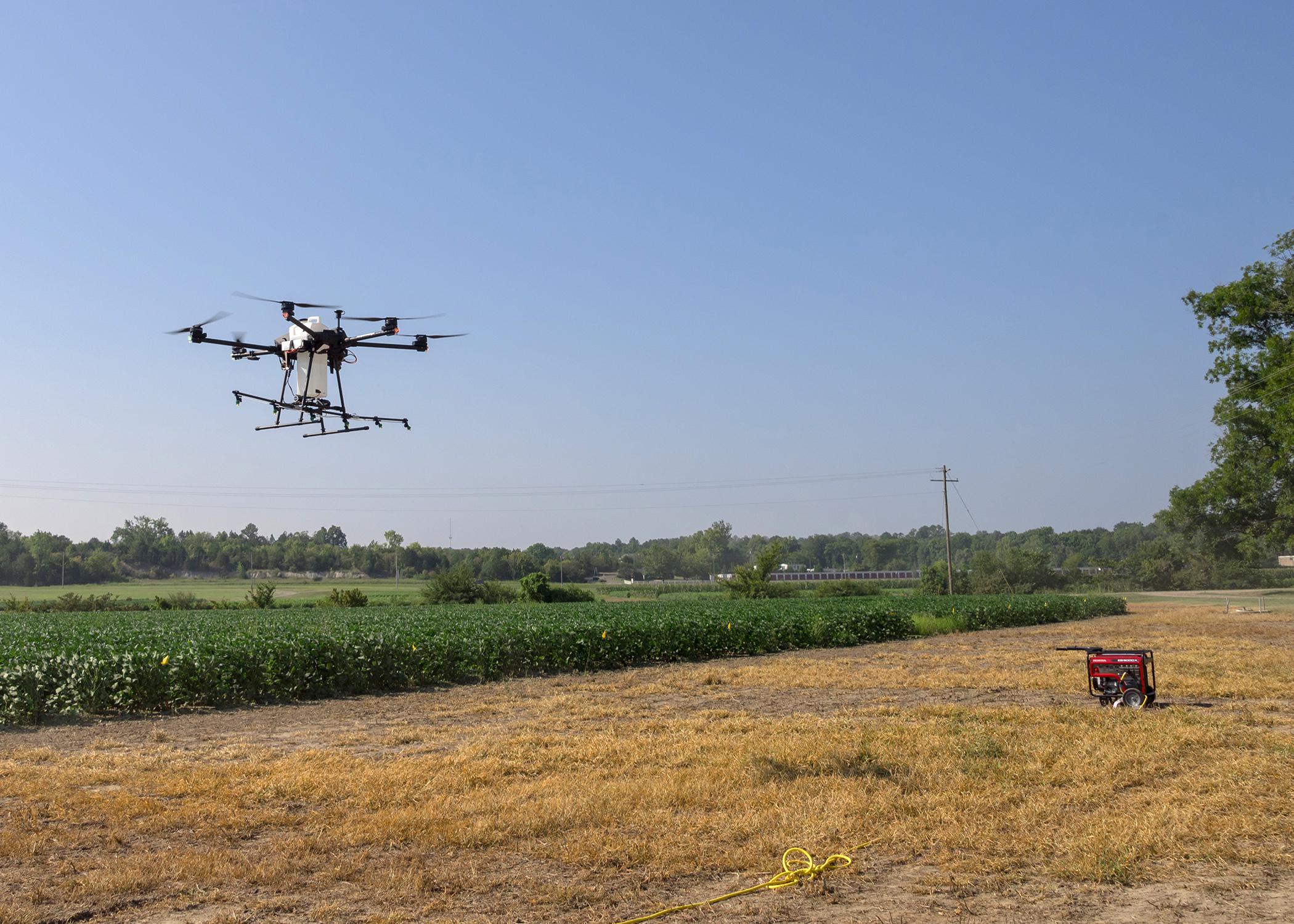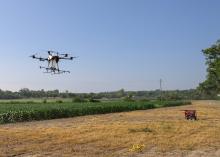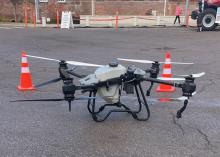MSU is studying UAVs’ usefulness in ag settings
STARKVILLE, Miss. -- Crop dusters are a familiar sight in the skies over agricultural regions, but much smaller versions, unmanned aerial vehicles, are joining them.
Unmanned aerial vehicles, or UAVs, are commonly called drones. Unmanned aerial systems, known as UAS, include the vehicle itself, payload, operator and control modules.
Mississippi State University is a leader in this new frontier through a variety of UAS research efforts and national designations. Madison Dixon, associate director of research at the MSU Agricultural Autonomy Institute, said the university has the largest U.S.-manufactured ag drone fleet in the country.
“With this fleet, we will be performing research flights, testing numerous variables and aiming to provide valuable data and insights to farmers,” Dixon said at a December presentation at the MSU Extension Row Crop Short Course. “We will test application efficacy of both liquid and dry agricultural products and will find ways to mitigate off-target drift.”
Ag drones today have been equipped with tanks and nozzles to spray crops with water-based solutions as well as hoppers and spreaders for dispersing dry material. To date, applications include cover crop seeding; weed, insect and disease control; as well as crop imaging when combined with cameras and sensors.
Dixon said MSU is focused only on U.S. made spray drones, as certain foreign manufactured drones are at risk of being grounded due to cybersecurity vulnerabilities.
“One of the things we’re doing is validating aircraft specifications and real-world operational performance,” Dixon said. “If the drone is advertised to fly for 20 minutes per flight but it only flies for 10 minutes in moderate wind conditions, that is a huge difference. So, we’re testing to determine how they truly perform in real-world use.”
MSU currently is working with a Hylio AG-272 UAS that has an 18-gallon payload capacity and weighs up to 400 pounds at takeoff. The Federal Aviation Administration has already approved even larger unmanned aircrafts with some weighing over 1,100 pounds.
“There is an urgent need for UAS applicator training and certification, as well as low-altitude airspace deconfliction,” Dixon said. “We have to make sure these spray drones do not end up in the same locations and altitudes at the same time as our traditional ag aviators.”
MSU is not the only university addressing the need for research and support of UAS in agriculture. Steve Li from Auburn University presented data at the Row Crop Short Course on his field evaluations of spray drones.
“Be aware of the labor requirement and how tedious and hot it is,” Li said. “It takes a lot of time to fold and unfold these UAVs for use, and we found we are doing tank refills and swapping batteries every five minutes. It is physically challenging to do this is the summertime in a field.”
Li has been looking at pre-planting burndown of weeds with a drone and found they can perform this task very well under optimal weather conditions.
“If you map and plan flight routes well, you can do a very good job with very clean, sharp edges,” he said.
Daniel Martin of the U.S. Department of Agriculture called spray drones an emerging technology that offers one more tool for the toolbox.
“About 98% of drone use in agriculture to date has applications in remote sensing,” Martin said.
Although they are being studied more for their ability to carry a payload for delivery over a crop, the first challenge is weight. A large UAV may be able to carry 25 gallons of liquid.
“Commercial manned aviation holds up to 800 to 1,000 gallons of liquid,” Martin said. “A drone may have 10 minutes of battery time, and they fly a 20 to 25-foot swath compared to 80 feet for airplanes.”
Martin said in his work, a typical small UAV can cover a little over half an acre per minute and only about 6 acres per battery set.
“With a 12-minute turnaround, that means we can cover about 30 acres an hour,” he said.
While that cannot compete with traditional aerial applications by airplane or helicopter, UAVs can tremendously complement aircraft in spot spraying. This includes specific areas within a field as well as crop edges and near overhead power lines and other obstructions.
“You can use an aircraft to spray the big, broad areas and use a drone for the edges and the dangerous areas,” Martin said. “They can be used on small farms and vineyards.”
Choosing the right nozzle for the application is vital. Studies have shown that coarse spray drifts the least, but finer sprays may be needed for certain applications.
“We’ve looked at where the nozzles were placed on the drone itself and found a lot of variability,” Martin said. “Pattern test your aircraft before use and understand the limitations of the system.”
UAV-application of farm chemicals is new enough that the Environmental Protection Agency, or EPA, and most states are currently allowing a drone to apply a product that is labeled for aerial use. Martin said chemical manufacturers are working with the EPA to ensure the labels are appropriate for these applications.
MSU’s drone fleet also supports a larger vision for a future MSU-led UAS aerial application training program.
“Delta State University is training traditional ag pilots, and MSU can really complement that by filling the tremendous need to train UAS applicators,” Dixon said.





